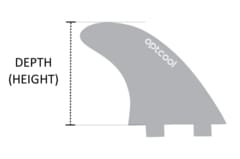SURFBOARD Fins
THE PURPOSE OF A SURF FINS
- Designed to enhance board performance.
- Make a huge difference to the stability, feel and your ability to control your board.
KEY CHARACTERISTICS OF SURFING FINS
1. BASE (LENGTH)
- The base length of the fin is the widest point of the fin.
- Affects the way a board will turn and drive.
- Longer base provides more surface area to push against the water.
(Turns are stronger and drive is increased) - Shorter base allow the board to turn sharply.

2. DEPTH (HEIGHT)
- The distance the fin penetrates into the water.
- Depth directly relates to hold and stability.
- Greater depth the more hold.
(Providing the rider more control) - Shorter depth the more a board will slide and release.

3. SWEEP (RAKE)
- The angle measuring how far the outline of the fin is curved backwards.
- Directly influence on pivot.
- More sweep produce a longer turning arc.
- Less sweep offers a tighter turning arc.

4. AREA
- Area is the total surface area of the fin.

5. FLEX
- Affect the way a surfboard rides.
STIFF FINS
GREAT for beginner.
More forgiving, stable and predictable.
Give you the stability you need.
FLEXIER FINS
GREAT for making fast, sharp turns.
Provide a skatier feel on more playful waves.

6. FOIL
- An aerodynamic shape from front to back of the fin.
- The major influence on the overall performance of a fin.
- Determine how the water flows across the surface of the fin
- Directly affect properties such as speed, hold and release.
INSIDE FOIL
Rounded leading edge, concave inside face.
Inside foil increases efficient water flow.
Adds lift and hold while reducing drag.
Helps surfers maintain speed through turns.

FLAT FOIL
Even combination of drive, pivot and hold.
Fast directional changes.
Preferred by advanced and pro surfers.

50/50 FOIL
Symmetrical foil used on centre fins and sometimes quad rears.
Even water flow creates stability and control.

80/20 + 70/30 FOIL
Asymmetrical foil typically used for quad rear fins.
Allows for fast turning sensitivity while still providing stability and control.

SETUPS / PLACEMENT
The optimal fin setup for a wave type is as follows:


1. SINGLE FIN
- The most traditional surfboard fin.
- Typical on longboards or beginning surfboards.
- Limitation on turning.
- Provide stability, control, and predictability to your longboard.
2. TWIN FIN
- Hard to control in large waves.
- Most common on shortboards or fish boards.
- Two fin setup encourages speed.
- Offer good maneuverability in smaller conditions.
3. THRUSTER / TRI FIN
- The most common setup.
- Found on a variety of surfboard shapes and sizes.
- Outside fins are flat on the inside to increase drive.
- Outer fins are toed-in to speed up the board.
- Allow to turn more easy.
4. QUAD FIN
- Offer speed in smaller surf by channeling the water to the end of the surfboard and out the tail for acceleration.
- Provide stability and hold in big-wave surfing.
5. FIVE-FIN
- Allow to mix and match fins depending on your preference and the surf conditions.

